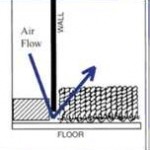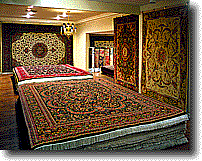A brief description of Filtration Soiling is available from the Carpet & Rug Institute: www.carpet-rug.org
Filtration soil
“Filtration soil may appear as dark or grayish lines on carpet along walls, stairways and under doors. It is caused by airflow over and through carpet, allowing fine soils to settle on the surface. It is often caused by an improperly balanced ventilation system, when the volume of air entering a room exceeds the system’s capacity to remove air from the room. Excess air then seeks exit sources in gaps along walls and stairways. Prevent the airflow through carpet and carpet edges by sealing openings through the carpet and under doors and baseboards. Keeping the air in the area clean and using good filtration in your heating and cooling systems and vacuum cleaners can help. Filtration soils may require special cleaning treatment for effective removal.”
 This is the most common cause of Filtration Soiling
This is the most common cause of Filtration Soiling
What makes this type of soil so difficult (if not impossible) to fully remove is the nature of the soil itself. Since the soil particles are so small they can penetrate deep into carpet fibers. Also, most of these soils contain some type of oil which binds the particles to the carpet and since people tend not to vacuum around the edges of a room filtration soils accumulate over time.
Filtration soiling can’t always be completely removed. The degree of soil removal will depend on the amount and type of soil, how long the soil has remained on the carpet, and the type and color of the carpet fibers. On most synthetic carpeting soil filtration can be effectively remediated (most likely not totally removed) through the use of aggressive cleaning techniques. However, due to the nature of wool and other natural fiber carpets these aggressive cleaning techniques are not recommended.
The two areas of concern usually are:
- Preventing filtration soiling from occurring
- Removing existing filtration soils
PREVENTION:
- As much as possible keep your home (& office) dust free. Limit candle burning and clean hard surfaces regularly.
- Vacuum all carpet surfaces at least weekly, including areas where the carpet contacts walls (use a crevice tool) and under door threshold areas as well as around heating registers. Don’t forget the left & right sides of stairs, both the risers and treads.
- Ventilation system-Keep the filters clean and the system maintained to ensure clean air is being circulated throughout the home or office during both the heating and cooling seasons.
- Run a damp cloth along the carpet adjacent to baseboards and heat registers after vacuuming.
REMOVAL: (Remember: Complete removal may not be possible.)
 Professional Filtration Soil removal
Professional Filtration Soil removal
- Start with aggressively vacuuming along the complete length of the filtration line. Get as much dry soil out as possible.
- Apply an aggressive detergent (if carpet is synthetic) to filtration line. Detergents should be at least warm, hot will be more affective. Agitate or brush in the detergent assuring deep penetration and allow the detergents to dwell a minimum of 15 minutes.
- Extract the residue using Hot Water Extraction cleaning-repeat the above steps if necessary-being careful not abraid of pull carpet tufts from their foundation yarns.
- Apply oxidation (synthetic carpet only) to remove residual discoloration.
Now you have a happy and SAFE Home…Enjoy!
 Clean Carpet is Sanitary Carpet!
Clean Carpet is Sanitary Carpet!


